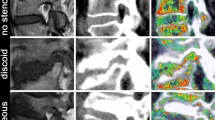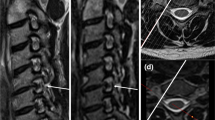Abstract
Objective
The aim of this study was to evaluate the diagnostic performance of susceptibility-weighted magnetic resonance imaging (SW-MRI) for the evaluation of osseous foraminal stenosis (FS) of the cervical spine compared to conventional MRI-sequences, using computed tomography (CT) as a reference standard.
Materials and methods
Twenty-one patients with suspected radiculopathy of the cervical spine were prospectively included. CT and MRI data sets were available for all patients. As standard of reference, 280 neuroforamina of the cervical spine, including 58 foraminal stenosis, were identified on sagittal CT images. T1-, T2-, and SW-MRI of the cervical spine were performed. The presence of foraminal stenosis was assessed on sagittal views in all sequences. Sensitivity and specificity were calculated and differences in detection rate and severity scoring of foraminal stenosis between the different sequences were tested. CT was used as reference standard for all analysis.
Results
Fifty-six of 58 osseous foraminal stenosis could be correctly identified on SW-MR magnitude images. SW-MRI achieved a sensitivity of 96.6% and specificity of 99.5% for the identification of foraminal stenosis. In comparison, conventional T1-weighted MRI sequences achieved a sensitivity and specificity of 43.1% and 100% respectively. T2-weighted MRI sequences achieved a sensitivity and specificity of 65.5% and 99.1%, respectively. The overall detection rate was significantly (p < 0.05) higher on SW-MRI and there was no significant difference (p > 0.05) in severity scoring compared to CT. T1- and T2-weighted MRI underestimated the degree of foraminal stenosis. Intermodality and interobserver agreements were highest for SW-MRI.
Conclusions
SW-MRI enables the reliable detection of osseous foraminal stenosis of the cervical spine in patients with spinal radiculopathy with a higher sensitivity compared to conventional T1- and T2-MRI sequences, with CT as a reference standard.
Key Points
• Susceptibility-weighted magnetic resonance imaging enables the reliable detection of osseous foraminal stenosis of the cervical spine with CT as a reference standard.
• This could be relevant for younger patients in order to prevent unnecessary radiation exposure.
• This may also facilitate a one-stop-shop approach and speed up diagnostic work-up.






Similar content being viewed by others
Abbreviations
- CT:
-
Computed tomography
- FOV:
-
Field of view
- GRE:
-
Gradient echo
- MEDIC:
-
Multi echo data image combination
- MR:
-
Magnetic resonance
- MRI:
-
Magnetic resonance imaging
- MSK:
-
Musculoskeletal
- SD:
-
Standard deviation
- STIR:
-
Short tau inversion recovery
- SW-MRI:
-
Susceptibility-weighted magnetic resonance imaging
- TE:
-
Echo time
- TR:
-
Repetition time
- TSE:
-
Turbo spin echo
References
Bai Y, Wang MY, Han YH et al (2013) Susceptibility weighted imaging: a new tool in the diagnosis of prostate cancer and detection of prostatic calcification. PLoS One 8:e53237
Caridi JM, Pumberger M, Hughes AP (2011) Cervical radiculopathy: a review. HSS J 7:265–272
Cheng AL, Batool S, McCreary CR et al (2013) Susceptibility-weighted imaging is more reliable than T2*-weighted gradient-recalled echo MRI for detecting microbleeds. Stroke 44:2782–2786
Eubanks JD (2010) Cervical radiculopathy: nonoperative management of neck pain and radicular symptoms. Am Fam Physician 81:33–40
Fu MC, Webb ML, Buerba RA et al (2016) Comparison of agreement of cervical spine degenerative pathology findings in magnetic resonance imaging studies. Spine J 16:42–48
Haacke EM, Mittal S, Wu Z, Neelavalli J, Cheng YC (2009) Susceptibility-weighted imaging: technical aspects and clinical applications, part 1. AJNR Am J Neuroradiol 30:19–30
Kaiser JA, Holland BA (1998) Imaging of the cervical spine. Spine (Phila Pa 1976) 23:2701–2712
Kim KT, Kim YB (2010) Cervical radiculopathy due to cervical degenerative diseases : anatomy, diagnosis and treatment. J Korean Neurosurg Soc 48:473–479
Kuijper B, Beelen A, van der Kallen BF et al (2011) Interobserver agreement on MRI evaluation of patients with cervical radiculopathy. Clin Radiol 66:25–29
Kurz FT, Freitag M, Schlemmer HP, Bendszus M, Ziener CH (2016) Principles and applications of susceptibility weighted imaging. Radiologe 56:124–136
Mittal S, Wu Z, Neelavalli J, Haacke EM (2009) Susceptibility-weighted imaging: technical aspects and clinical applications, part 2. AJNR Am J Neuroradiol 30:232–252
Modic MT, Masaryk TJ, Ross JS, Mulopulos GP, Bundschuh CV, Bohlman H (1987) Cervical radiculopathy: value of oblique MR imaging. Radiology 163:227–231
Park HJ, Kim SS, Han CH et al (2014) The clinical correlation of a new practical MRI method for grading cervical neural foraminal stenosis based on oblique sagittal images. AJR Am J Roentgenol 203:412–417
Park HJ, Kim JH, Lee JW et al (2015) Clinical correlation of a new and practical magnetic resonance grading system for cervical foraminal stenosis assessment. Acta Radiol 1987(56):727–732
Park MS, Moon SH, Lee HM et al (2015) Diagnostic value of oblique magnetic resonance images for evaluating cervical foraminal stenosis. Spine J 15:607–611
Reichenbach JR, Haacke EM (2001) High-resolution BOLD venographic imaging: a window into brain function. NMR Biomed 14:453–467
Reul J, Gievers B, Weis J, Thron A (1995) Assessment of the narrow cervical spinal canal: a prospective comparison of MRI, myelography and CT-myelography. Neuroradiology 37:187–191
Rhee JM, Yoon T, Riew KD (2007) Cervical radiculopathy. J Am Acad Orthop Surg 15:486–494
Ross JS, Ruggieri PM, Glicklich M et al (1993) 3D MRI of the cervical spine: low flip angle FISP vs. Gd-DTPA TurboFLASH in degenerative disk disease. J Comput Assist Tomogr 17:26–33
Ruggieri PM (1995) Cervical radiculopathy. Neuroimaging Clin N Am 5:349–366
Shafaie FF, Wippold FJ 2nd, Gado M, Pilgram TK, Riew KD (1999) Comparison of computed tomography myelography and magnetic resonance imaging in the evaluation of cervical spondylotic myelopathy and radiculopathy. Spine 24:1781–1785
Simpson AK, Sabino J, Whang P, Emerson JW, Grauer JN (2009) The assessment of cervical foramina with oblique radiographs: the effect of film angle on foraminal area. J Spinal Disord Tech 22:21–25
Straub S, Laun FB, Emmerich J et al (2017) Potential of quantitative susceptibility mapping for detection of prostatic calcifications. J Magn Reson Imaging 45:889–898
Van de Kelft E, van Vyve M (1994) Diagnostic imaging algorithm for cervical soft disc herniation. J Neurol Neurosurg Psychiatry 57:724–728
Yousem DM, Atlas SW, Goldberg HI, Grossman RI (1991) Degenerative narrowing of the cervical spine neural foramina: evaluation with high-resolution 3DFT gradient-echo MR imaging. AJNR Am J Neuroradiol 12:229–236
Funding
The authors state that this work has not received any funding.
Author information
Authors and Affiliations
Corresponding author
Ethics declarations
Guarantor
The scientific guarantor of this publication is Yvonne Y. Bender.
Conflict of interest
The authors of this manuscript declare a relationship with Siemens Healthineers AG. Siemens Heathineers AG provided financial and technical support for conducting the study. Siemens Heathineers AG did not have control over the study conduct or data analysis.
Statistics and biometry
No complex statistical methods were necessary for this paper.
Informed consent
Written informed consent was obtained from all subjects (patients) in this study.
Ethical approval
Institutional Review Board approval was obtained.
Methodology
• Prospective
• Diagnostic or prognostic study
• Performed at one institution
Rights and permissions
About this article
Cite this article
Engel, G., Bender, Y.Y., Adams, L.C. et al. Evaluation of osseous cervical foraminal stenosis in spinal radiculopathy using susceptibility-weighted magnetic resonance imaging. Eur Radiol 29, 1855–1862 (2019). https://doi.org/10.1007/s00330-018-5769-4
Received:
Revised:
Accepted:
Published:
Issue Date:
DOI: https://doi.org/10.1007/s00330-018-5769-4




